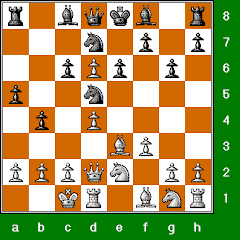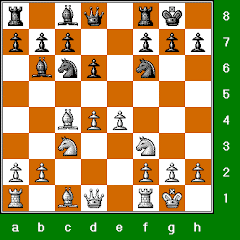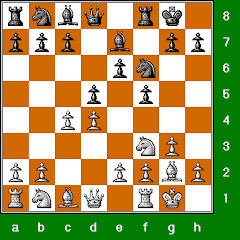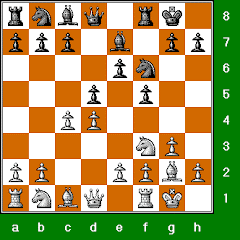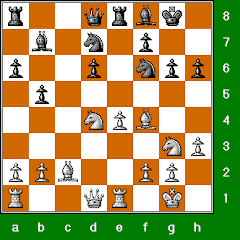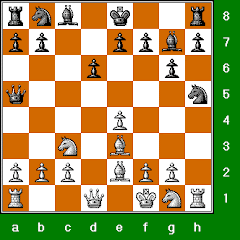Sicilian Defense:
1 e4 c5 2 Nf3 d6 3 d4 cxd4 4 Nxd4 Nf6
5 Nc3 a6:
6 Bg5 e5!? 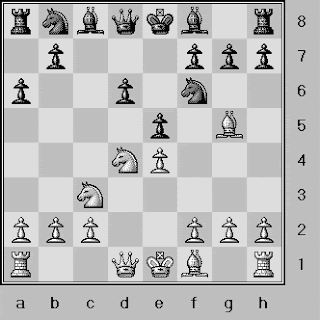
7 Nf5 
7 ... Bxf5
8 exf5
8 ... Nbd7 9 Bc4 Rc8
10 Bb3 Be7 11 O-O O-O
12 Bxf6 Nxf6 13 Qf3
13 ... b5 14 Rfd1.
"Passions, as usual, were running high
in the press centre, during the fifth game
of the match between Lev Polugayevsky
and Anatoly Karpov, challengers for the
world title. Where had Polugayevsky made
his fatal mistake? After all, Karpov’s
position had appeared critical.
There were doubts expressed, questions
asked and guesses made from every corner.
Paul Keres said nothing for a long time,
listening to everybody, and then proceeded
to demonstrate beautiful combinations and
paradoxical variations all showing the
possibilities latent in any, even seemingly
simple, position."
The Soviet Chess School
A. Kotov, M. Yudovich
6 ... e5!? 7 Nf5 Bxf5 8 exf5 Nbd7
9 Bc4 Rc8 10 Bb3 Be7 11 O-O O-O
12 Bxf6 Nxf6 13 Qf3 d5
14 Nxd5 Nxd5 15 Rfd1 e4.
‘In general, it was through a fortunate
accident that I ended up at Botvinnik-Kasparov
school. In Tuapse there was a great chess
enthusiast, who was not an expert and could
not assess my capabilities, but who was a fan
of mine. Without informing my parents or, of
course, me, he wrote to Botvinnik telling him
about me, an 11-year-old candidate master.
Botvinnik probably received hundreds of such
letters, and 98 out of every 100 would be not
worth bothering with. But this one he did not
tear up, did not throw in the bin, but he
replied and requested that some of my games
should be sent...Botvinnik looked through about
five games from the eleven that had been sent
to him, and said: “We must definitely admit this boy.” His colleagues objected: “Why hurry, Mikhail Moiseevich, let’s have a look at the other games too.” “Of course we’ll look at them,” answered Botvinnik, “but all the same we will take Kramnik.”’
Kramnik: My Life and Games
Vladimir Kramnik & Iakov Damsky
6 ... e5!? 7 Nf5 Bxf5 8 exf5 Nbd7
9 Bc4 Rc8 10 Bb3 Be7 11 O-O O-O
12 Bxf6 Nxf6 13 Qf3 d5
14 Rad1 d4 15 Qxb7 Qc7.
“Bobby Fischer had settled down to
play chess, and his complaints to
the referee from time to time that
‘there was a lot of whispering in
this room’ were the sole remaining
sign that he was not out of form.”
Fischer vs. Spassky:
The Chess Match of the Century
Described and Annotated by
Grandmaster Svetozar Gligoric
6 ... e5!? 7 Nf5 Bxf5 8 exf5 Nbd7
9 Bc4 Rc8 10 Bb3 Be7 11 O-O O-O
12 Bxf6 Nxf6 13 Qf3 d5
14 Rad1 e4 15 Qe2 Rxc3
16 bxc3.
“The event is the annual Hastings Chess Congress lasting from 30 December 1953 to 9 January 1954. It is the seventh round and David Bronstein, a grandmaster of the U.S.S.R., is leading in the Premier Tournament with 4 ½ points out of 6, just ½ point ahead of the British international master, C.H.O’D. Alexander. Now these two are due to meet and everything hangs on the result of their game. A draw will mean that Bronstein retains his lead with a very good chance of keeping it for the rest of the tournament. A loss for Alexander will make Bronstein’s final victory in the tournament a practical certainty. Only a win for the home player can change the course of events in his favour, and, as he has Black, all experts agree that this result is most unlikely.
Many games in ten different sections are in progress but the players in the Premier Tournament are in a separate division at one end of the hall and are roped off from the crowd of spectators that has come in especially to view the Bronstein-Alexander encounter. This turns out to be something well watching.
Bronstein takes the opening too lightly and is soon in difficulties. He offers a draw but Alexander, now a good Pawn up, rightly refuses and even goes on to win a second Pawn. The Russian grand-master fights desperately hard to avoid defeat and lavishes all his ingenuity on the position. All in vain, however against Alexander’s great play which is a just blend of combinative skill and meticulous accuracy. ”
The Game of Chess
H. Golombek
6 ... e5!? 7 Nf5 Bxf5 8 exf5 Nbd7
9 Bc4 Rc8 10 Bb3 Be7 11 O-O O-O
12 Bxf6 Nxf6 13 Qf3 d5
14 Rad1 e4 15 Qe2 Ba3
16 Bxd5 Qe7 17 Nxe4 Nxd5.
6 ... e5!? 7 Nf5 Bxf5 8 exf5 Nbd7
9 Bc4 Rc8 10 Bb3 Be7 11 O-O O-O
12 Bxf6 Nxf6 13 Qf3 d5
14 Rad1 e4 15 Qe2 Rc5
16 f3.
‘The incident I was about to describe to you occurred soon after Botvinnik’s victory over Chekhover, to whom he sacrificed, by way of preliminaries, at least half the pieces on the chessboard. The evening of that same day the chess players remained in the hall after the round, arguing about the correctness and the value of sacrifices in the game. Opinions differed widely. Spielmann asserted that 3 or 4 tempi were really not a bad compensation for a piece. Flohr said he would be glad even of a pawn as long as it was an extra one. Capablanca declared that he did not believe in the correctness of any sacrifices. In short, the atmosphere was tense and the weirdest moves were in the air.
I was sitting a little apart from the rest all the time and did not join in the discussion. At length, Capablanca turned to me and said:
“My dear Munchausen, do tell me what your opinion is on the subject.”
Then very loudly and distinctly, I replied:
“To tell you the truth I am not much inclined to talking. It would be simpler, I think, if I agreed to play with anyone you care to name, without any pieces, receiving no more than a tempo for each piece”
Upon hearing these words, spoken with my usual sangfroid, the company was silent for a while. At last Capablanca said rather dryly that audacity such as mine could not possibly be left unpunished and offered to play with me himself.’
The Complete Book of Chess
(Originally published as The Personality of Chess)
I.A. Horowitz and P.L. Rothenberg
6 ... e5!? 7 Nf5 Bxf5 8 exf5 Nbd7
9 Bc4 Rc8 10 Bb3 Be7 11 O-O O-O
12 Bxf6 Nxf6 13 Qf3 d5
14 Bxd5 Rxc3 15 Bxf7+ Rxf7
16 Qxc3.
6 ... e5!? 7 Nf5 Bxf5 8 exf5 Nbd7
9 Bc4 Rc8 10 Bd5 Qb6 11 Rb1 Nxd5
12 Nxd5 Qd4 13 Qxd4 exd4
14 Kd2 f6.
6 ... e5 7 Nf5 Bxf5 8 exf5 Nbd7
9 Bc4 Rc8 10 Bd5 Qb6 11 Rb1 Nxd5
12 Nxd5 Qb5 13 f6 Rc5
14 Nc3 Qc6 15 O-O d5.
Sicilian Defense:
1 e4 c5 2 Nf3 d6 3 d4 cxd4 4 Nxd4 Nf6
5 Nc3 a6:
6 Bg5 e5!? 
7 Bxf6
7 ... Qxf6 
8 Nd5 
8 ... Qd8 
9 Nf5 
9 ... Bxf5 
10 exf5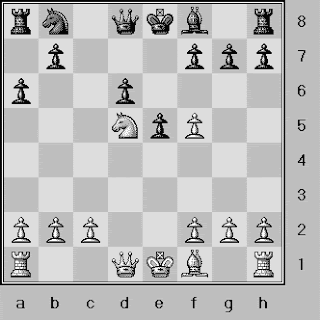
1 e4 c5 2 Nf3 d6 3 d4 cxd4
4 Nxd4 Nf6 5 Nc3 a6 6 Bg5 e5:
7 Bxf6 gxf6 8 Nb3.
1 e4 c5 2 Nf3 d6 3 d4 cxd4
4 Nxd4 Nf6 5 Nc3 a6 6 Bg5 e5:
7 Bxf6 gxf6 8 Nf5 Bxf5
9 exf5.
Chess: Why 6 Bg5 e5 Is Bad
Subscribe to:
Posts (Atom)

